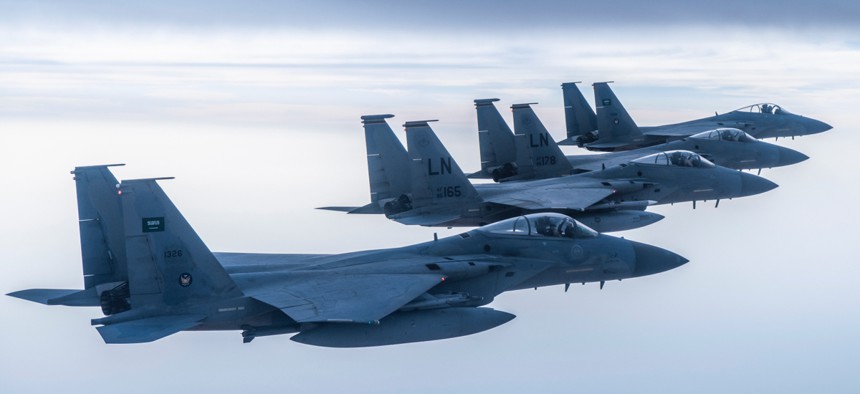
Royal Saudi Air Force F-15C Eagles fly in formation with U.S. Air Force F-15Cs in the Middle East. Royal Saudi Air Force
The US Exported Arms Worth $55B in the Past Year
That’s almost exactly the same as in fiscal 2018.
The U.S. exported weapons worth more than $110 billion over the past two years, a top Pentagon official said Tuesday.
That’s $55.4 billion in fiscal 2019, which ended on Sept. 30, and $55.6 billion in 2018, according to Lt. Gen. Charles Hooper, director of the Defense Security Cooperation Agency, the arm of the Pentagon that oversees foreign arms sales.
“Our strategic competitors are using their own defense exports in an attempt to degrade long-standing and emerging U.S. alliances and partnerships,” Hooper said Tuesday at the Association of the U.S. Army annual convention in Washington. “Accordingly, the U.S. government is organizing to ensure that our defense exports will prevail in an increasingly competitive global market and remain a vital pillar of U.S. defense and foreign policy.”
Recent fiscal years’ totals have included: 2017, $42 billion; 2016: $33.6 billion; 2015: $47 billion; and 2014: $34.2 billion.
“We do not measure our success by statistics alone, but the data is certainly a sign of increased activity,” Hooper said. “And as such, this activity offers us some opportunities.”
Hooper said that the three-year average of $51 billion is up 16.6 percent in a year. As of Sept. 30, the final day of fiscal 2019, the U.S. government is overseeing more than 14,700 foreign sales, the general said.
President Trump and administration officials have touted arms sales as a top foreign policy tool; in Hooper’s words: “security cooperation has been elevated to a tool of first resort for U.S. foreign policy.”
Trump has also touted arms deals as a way to create American jobs, but experts generally regard such deals as far less potent than claimed.
In fiscal 2019, the Trump administration approved $68 billion in arms deals, down from $70 billion in 2018 and $73 billion in 2017.
Just because a deal is approved doesn’t mean that a sale will go through. For instance, a country could choose a different weapon built in a different country or it could choose one U.S.-made weapon over similar U.S.-made weapons. Or a country could abandon a sale for political or budgetary reasons.
Of the $68 billion in arms deals approved in fiscal 2019, $13.5 billion of those are “politically sensitive deals” with Taiwan and Turkey, Roman Schweizer, a Cowen & Company analyst, wrote in an Oct. 4 note to investors.
Right now, there are more than 40 international competitions involving U.S. weapons, Hooper said.
